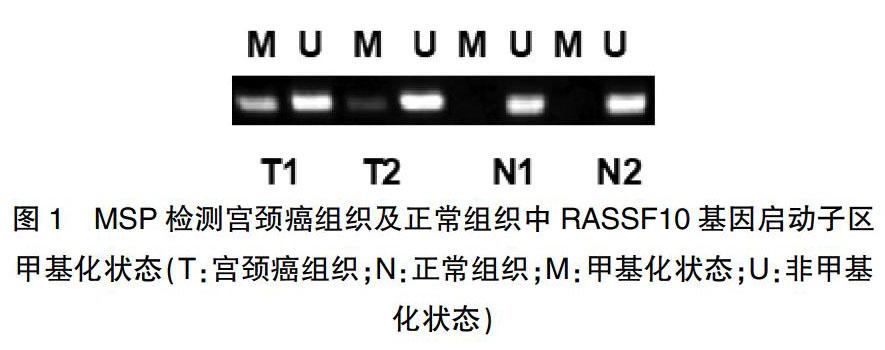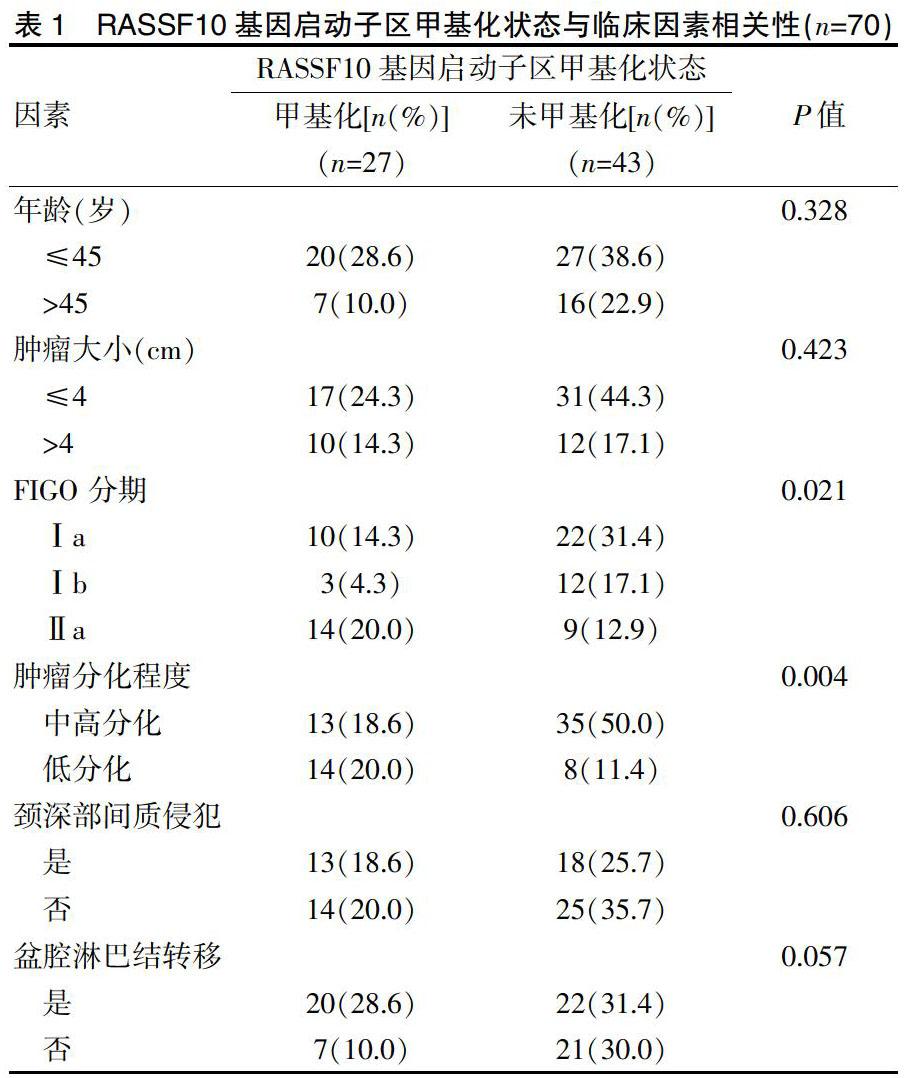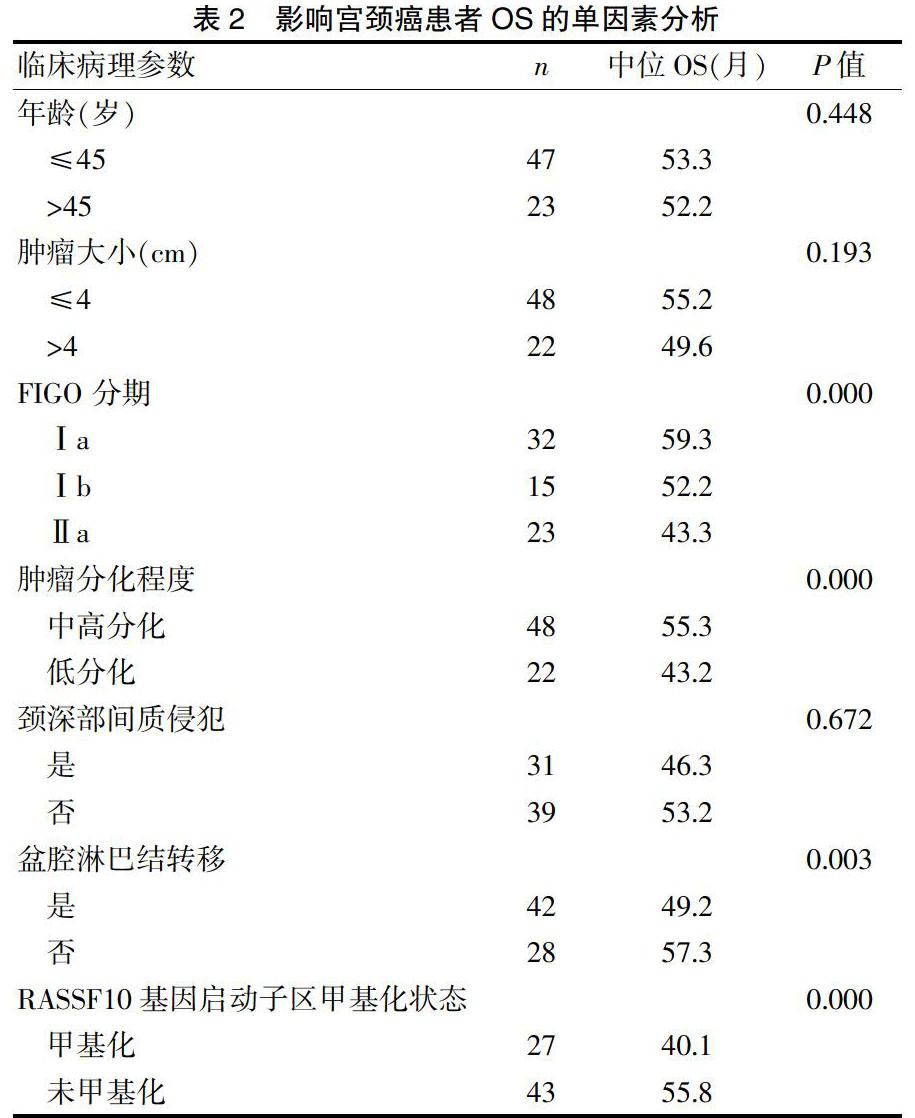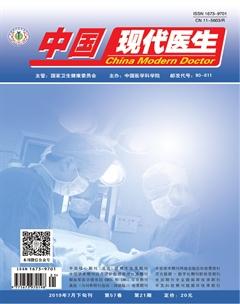RASSF10基因启动子区甲基化状态在宫颈癌中的临床应用
汪学昌 段婧



[摘要] 目的 探討RASSF10基因启动子区甲基化状态在宫颈癌中的临床意义。 方法 收集本院2005年6月~2013年12月经术后病理证实的70例宫颈癌患者,取其经手术切除癌组织70例和配对癌旁组织标本70例,采用甲基化特异性PCR(MSP)分析法检测RASSF10基因启动子区DNA甲基化状态,分析RASSF10基因启动子区甲基化状态与临床病理特征(年龄、肿瘤大小、颈深部间质侵犯、盆腔淋巴结转移、FIGO分期及肿瘤分级程度)的关系及宫颈癌预后的相关性因素分析。 结果 MSP检测发现宫颈癌组织中RASSF10基因启动子区甲基化为38.6%,未甲基化为43例(61.4%),而正常宫颈组织未见甲基化;宫颈癌中RASSF10基因启动子甲基化状态与年龄、肿瘤大小、颈深部间质侵犯及盆腔淋巴结转移无关(P>0.05),而与FIGO分期及肿瘤分化程度有关。70例宫颈癌患者的中位生存期与年龄、肿瘤大小及颈深部间质侵犯无关,但与FIGO分期、肿瘤分化程度、盆腔淋巴结转移及RASSF10基因启动子区甲基化有关,其中RASSF10基因启动子区甲基化者5年生存率为66.7%,未甲基化者的5年生存率为88.4%,差异具有统计学意义(P<0.05)。多因素分析结果显示FIGO 分期、肿瘤分化程度、盆腔淋巴结转移和RASSF10基因启动子区甲基化状态为本组宫颈癌患者预后独立因素。 结论 RASSF10基因启动子区甲基化在宫颈癌中高表达,且与FIGO分期、肿瘤分化程度及预后有关,可作为宫颈癌预后的参考指标。
[关键词] 宫颈癌;RASSF10;甲基化状态;MSP分析法
[中图分类号] R737.33 [文献标识码] B [文章编号] 1673-9701(2019)21-0082-04
Clinical application of methylation status of RASSF10 gene promoter region in cervical cancer
WANG Xuechang1 DUAN Jing2
1.Department of Oncology, the Fifth People's Hospital of Qinghai Province(Qinghai Cancer Hospital), Xining 810007, China; 2.Department of Ultrasound, the Fifth People's Hospital of Qinghai Province(Qinghai Cancer Hospital), Xining 810007, China
[Abstract] Objective To investigate the clinical significance of methylation status of RASSF10 gene promoter region in cervical cancer. Methods Seventy patients with cervical cancer who were confirmed by postoperative pathology from June 2005 to December 2013 were enrolled. 70 cases of surgically resected cancer tissues and 70 matched paracancerous tissues were selected for methylation-specific PCR. Methylation specific PCR(MSP) assay was used for DNA methylation status in the promoter region of RASSF10 gene. The relationship between the methylation status of RASSF10 gene promoter region and clinicopathological features(age, tumor size, deep cervical interstitial invasion, pelvic lymph node metastasis, FIGO stage and tumor grade) was analyzed. And the correlation factors of cervical cancer prognosis were analyzed. Results MSP assay showed that the methylation rate of promoter region of RASSF10 gene was 38.6% in cervical cancer tissues, and 43 cases(61.4%) were unmethylated, while no methylation was observed in normal cervical tissues. Methylation status of RASSF10 gene promoter in cervical cancer was not associated with age, tumor size, deep cervical interstitial invasion and pelvic lymph node metastasis(P>0.05), but was related to FIGO stage and tumor grade. The median survival of 70 patients with cervical cancer was not associated with age, tumor size, and deep interstitial invasion of the neck, but was associated with FIGO stage, tumor grade, pelvic lymph node metastasis, and methylation of the RASSF10 gene promoter region, in which the 5-year survival rate of RASSF10 gene promoter region was 66.7%, and the 5-year survival rate of unmethylated patients was 88.4%. The difference was statistically significant(P<0.05). Multivariate analysis showed that FIGO stage, tumor differentiation, pelvic lymph node metastasis and methylation status of RASSF10 gene promoter region were independent prognostic factors for cervical cancer patients. Conclusion The promoter methylation of RASSF10 gene is highly expressed in cervical cancer, and it is related to FIGO stage, tumor differentiation and prognosis. It can be used as a reference index for prognosis of cervical cancer.
[Key words] Cervical cancer; RASSF10; Methylation status; MSP analysis
宫颈癌是妇科常见的恶性肿瘤,位居女性恶性肿瘤第3位,死亡率和发病率较高[1-2]。近些年随着诊断技术和治疗方法的不断改进,宫颈癌预后明显改善,但远期疗效仍较差[3]。分子生物学研究发现HPV感染、环境、遗传和表观遗传因素在宫颈癌发生过程中起重要作用[4]。表观遗传学是指基因表达的遗传发生变化而本身的DNA并未发生变化。组蛋白甲基化是表观遗传学的重要组成之一,目前已经证明甲基化在染色体稳定性、基因表达、基因组印迹和转录沉默中起着关键作用,同样也与肿瘤的发生密切相关[3]。研究表明RASSF10(Ras-association domain family 10,RASSF 10)基因在肿瘤发生过程中调节细胞周期及细胞凋亡,进而影响肿瘤分子生物学。目前发现RASSF10基因在多种肿瘤中例如食管鳞癌、结肠癌、肺癌等表达降低,究其原因与RASSF10基因启动子区甲基化密切相关[5],RASSF10基因甲基化与肿瘤诊断和预后密切相关[6,7]。然而在宫颈癌中RASSF10基因表达及其甲基化状态文献研究相对较少。本研究探讨RASSF10基因启动子区甲基化状态在宫颈癌中的临床意义。
1 资料与方法
1.1一般资料
选择青海省第五人民医院2005年6月~2013年12月经术后病理证实为宫颈癌患者70例,组织类型均为鳞状细胞癌,FIGO分期为Ⅰ~Ⅱa,年龄35~77岁,平均(52.12±4.12)岁;ECOG评分0~2分。本研究通过医院伦理委员会审批通过,所有患者入组前均签署知情同意书。
1.2 入组标准
(1)术后病理证实为FIGO Ⅰ~Ⅱa宫颈癌患者;(2)行根治性子宫切除术和双侧盆腔淋巴结清扫术的患者;(3)匹配手术标本和邻近正常宫颈组织的患者;(4)临床资料及随访资料完整。
1.3 排除标准
(1)姑息性手术患者;(2)术中证实有远处转移或腹膜播散的患者;(3)术后住院期间或术后1个月内死亡的患者。
1.4 甲基化特异性PCR
使用TrIZOL试剂盒(Invitrogen,Carlsbad,CA)从宫颈癌组织和正常宫颈组织中提取RNA。引物用于检测RASSF10启动子的甲基化(M)或未甲基化(U)等位基因:甲基化等位基因RASSF10 forwar(5-GGG-TATTTTGGGTAGAGTTAGAGC-3′),和reverse(5-AAACAAACTAAAAAACGACTACGAC - 3′);未甲基化等位基因RASSF10 forward(5′-GGGTATTTTGGGTAGAGTTAGAGTG-3′,reverse(5-AAAACAAACTAAAA-AACAACTACAAC-3′)。使用扩增产物TAGQ(甲基化特异性引物、退火温度600°C、非甲基化特异性引物、退火温度580℃)对MSP进行25个循环。后对MSP引物进行鉴定,以确定是否扩增出任何未饱和DNA,并通过直接测序某些PCR产物进一步证实MSP的特异性。用2%琼脂糖凝胶进行PCR检测。用Image J软件计算宫颈腺癌组织中RASSF10基因启动子区甲基化的相对值。RASSF10启动子的甲基化被定义为宫颈腺癌组织的甲基化值不低于阳性对照值。
1.5 随访
对患者定期复查,术后第1年每3个月1次,第2年每6个月1次,以后每年1次。复查时记录患者有无复发、转移事件。随访方式为电话随访,随访截止时间2019年1月8日或总体生存期60个月(超过60个月按60个月计算)。总体生存期(OS)定义为从随机化到任何原因的死亡时间或者最后随访时间。
1.6 统计学分析
采用SPSS20.0统计软件包进行分析。计量资料以均数±标准差表示,计数资料采用率表示并行χ2检验,预后因素分析采用 Cox风险比例回归模型。P<0.05为差异有统计学意义。
2 结果
2.1 本组宫颈癌组织中RASSF10基因启动子区甲基化状态表达
MSP法检测发现本组宫颈癌组织中RASSF10基因启动子区甲基化为27例(38.6%),未甲基化为43例(61.4%),而正常宫颈组织未见甲基化,差异具有统计学意义(P<0.05)(图1)。
2.2 RASSF10基因启动子区甲基化状态与临床因素相关性
RASSF10基因启动子区甲基化状态表达与FIGO分期(P=0.021)和肿瘤分化程度(P=0.004)密切相关,而年龄、肿瘤大小、颈深部间质侵犯及盆腔淋巴结转移与RASSF10基因启动子区甲基化状态无关(P>0.05)(表1)。
2.3 RASSF10基因启动子区甲基化状态与宫颈癌预后的关系
全组获随访时间48~60个月,中位生存期与年龄、肿瘤大小及颈深部间质侵犯无关,但与FIGO分期、肿瘤分化程度、盆腔淋巴结转移及RASSF10基因启动子区甲基化有关(表2)。
2.4影响宫颈癌患者OS的多因素分析
将单因素分析中影响OS的4个因素纳入多因素分析,结果显示FIGO 分期、肿瘤分化程度、盆腔淋巴结转移和RASSF10基因启动子区甲基化状态为本组宫颈癌患者的预后独立因素(表3)。
2.5 生存分析
本组宫颈癌患者中RASSF10基因启动子区甲基化的5年生存率为66.7%,未甲基化者88.4%,差异具有统计学意义(P<0.05)(表4)。
3讨论
Ras相关域家族共包含10个成员[8]。RASSF10基因属于N-端家族成员之一,编码N-端RA相关域。该基因为单一外显子基因,编码507个氨基酸,定位于染色体11p15.2,位置上靠近RRAS2基因。RASSF10基因启动子区含有CpG岛,RASSF10在癌症中的低表达与启动子区CpG岛的甲基化相关[9-10]。DNA甲基化通常是DNA的CG两个核苷酸的胞嘧啶被选择性地添加甲基,形成5-甲基胞嘧啶,这常见于基因的5'-CG-3'序列,DNA甲基化主要形成5-甲基胞嘧啶(5-mC)和少量的N6-甲基嘌呤(N6-mA)及7-甲基鸟嘌呤(7-mG)[11]。RASSF10基因在多种肿瘤中发生甲基化导致表达降低。Lu等[12]在食管癌细胞系中检测RASSF10基因mRNA表达水平的缺失或降低,并发现启动子甲基化的发生,用去甲基化药物5-aza-dC处理后,其表达得以恢复或提高。此研究证明RASSF10基因CpG岛的甲基化可導致该基因在肿瘤中的沉默。在甲状腺癌中有学者研究发现RASSF10基因在原发性甲状腺癌中甲基化率为高于滤泡状腺瘤中甲基化率,而正常甲状腺组织中均未发现甲基化,说明RASS F10基因甲基化可能与肿瘤发生密切相关[13]。RASSF10基因甲基化状态可为预后预测指标,Jingyu Deng等[14]在胃癌中发现RASSF10基因启动子区甲基化患者比RASSF10启动子未甲基化患者的中位生存期明显短。并且RASSF10启动子甲基状态是胃癌患者预后的独立预测因子。本研究回顾分析本院收治的宫颈癌患者,探讨RASSF10基因启动子区甲基化状态在宫颈癌中的临床价值。
本研究中首先检测RASSF10基因甲基化状态。目前检测DNA甲基化常见的方法主要有酶切法、直接测序法、MSP等,MSP与其他方法相比避免使用限制性内切酶,敏感性高,简便易行,适用于大样本检测,为检测DNA甲基化较为可信的方法[15]。本研究采用MSP法检测RASSF10基因启动子区甲基化状态。结果显示,27例患者出现RASSF10基因启动子区甲基化,而43例患者并未出现RASSF10基因启动子区甲基化,而正常宫颈组织中未发现RASSF10启动子區甲基化,这些结果表明RASSF10基因在宫颈癌中低表达与启动子区甲基化密切相关。进一步探讨RASSF10基因启动子区甲基化状态与临床因素之间的相关性发现FIGO分期和肿瘤分化程度等为RASSF10基因启动子区甲基化状态密切相关,深入发现Ⅱa期宫颈癌与低分化癌患者RASSF10基因启动子区甲基化较多,此结果可能暗示RASSF10基因甲基化后表达降低,进而影响下游分子通路导致肿瘤进展。为评价RASSF10基因启动子区甲基化状态在宫颈腺癌中的预后价值,本研究采用预后生存分析,结果显示RASSF10基因启动子区甲基化状态为本组患者独立预后因素,RASSF10基因启动子区甲基化患者预后比RASSF10基因启动子区未甲基化患者差。此研究表明RASSF10基因启动子区甲基化状态可为宫颈腺癌患者预后预测因子。
综上所述,宫颈癌中RASSF10基因低表达与启动子区甲基化相关,RASSF10基因启动子甲基化状态与宫颈腺癌患者预后密切相关,可作为宫颈癌预后预测指标。
[参考文献]
[1] 任康,申良方,周琴,等.局部晚期宫颈癌预后因素的研究进展[J].中国现代医学杂志,2019,29(2):38-43.
[2] 何潇.参芪扶正抗癌汤联合放化疗治疗宫颈癌的疗效观察及对生存质量的影响[J].中国中医药科技,2019, 26(1):80-82.
[3] Feng Y,Zhang Z,Lou T,et al.The safety of fertility preservation for microinvasive cervical adenocarcinoma:A meta-analysis and trial sequential analysis[J].Arch Gynecol Obstet,2018.
[4] Rabelo-Santos SH,Termini L,Boccardo E,et al.Strong SOD2 expression and HPV-16/18 positivity are independent events in cervical cancer[J].Oncotarget,2018,9(31):21630-21640.
[5] Jin Y,Cao B,Zhang M,et al.RASSF10 suppresses hepatocellular carcinoma growth by activating P53 signaling and methylation of RASSF10 is a docetaxel resistant marker[J].Genes Cancer,2015,6(5):231-240.
[6] Ma J,Zhang S,Hu Y,et al. Decreased expression of RASSF10 correlates with poor prognosis in patients with colorectal[J]. Cancer Medicine,2017,96(42):7011.
[7] Wang F,Li P,Feng Y,et al.Low expression of RASSF10 is associated with poor survival in patients with colorectal cancer[J].Hum Pathol,2017,6(2):108-114.
[8] Richter AM,Walesch SK,Dammann RH.Aberrant promoter methylation of the tumour suppressor RASSF10 and its growth inhibitory function in breast cancer[J].Cancers (Basel),2016,8(3):221-230.
[9] 崔建利,郭炜,郭艳丽,等. RASSF10基因在贲门腺癌组织中的甲基化状态及表达[J].中国癌症杂志,2014, 24(8):568-574.
[10] Dong T,Zhang Y. Methylation of RASSF10 promotes cell proliferation and serves as a docetaxel resistant marker in human breast cancer[J].Discover Med,2015,20(111):261-271.
[11] Li X,Liang Q,Liu W,et al.Ras association domain family member 10 suppresses gastric cancer growth by cooperating with GSTP1 to regulate JNK/c-Jun/AP-1 pathway[J].Oncogene,2016,35(19):2453-2464.
[12] Lu D,Ma J,Zhan Q,et al.Epigenetic silencing of RASSF10 promotes tumor growth in esophageal squamous cell carcinoma[J].Discov Med,2014,17(94):169-178.
[13] Schagdarsurengin U,Richter AM,W?觟hler C,et al.Frequent epigenetic inactivation of RASSF10 in thyroid cancer[J].Epigenetics,2009,4(8):571-576.
[14] Jingyu Deng,Han Liang,Guoguang Ying,et al.Methylation of ras association domain protein 10 (RASSF10) promoter negative association with the survival of gastric cancer[J].Am J Cancer Res,2014,4(6):916-923.
[15] Richter AM,Zimmermann T,Haag T,et al.Promoter methylation status of Ras-association domain family members in pheochromocytoma[J].Front Endocrinol(Lausanne),2015,6(1):21-24.

